Key takeaways:
- GDPR emphasizes the importance of transparency, consent, and data minimization, fostering trust and credibility in consumer relationships.
- Compliance is viewed as an opportunity to respect consumer rights rather than merely a legal obligation, enhancing brand loyalty and strategic marketing efforts.
- Effective strategies for GDPR compliance include conducting data audits, implementing clear privacy policies, and ongoing team training to cultivate a culture of respect for data protection.
- Challenges such as understanding consent nuances and managing excessive data highlight the importance of appropriate technology and clear practices in achieving compliance.
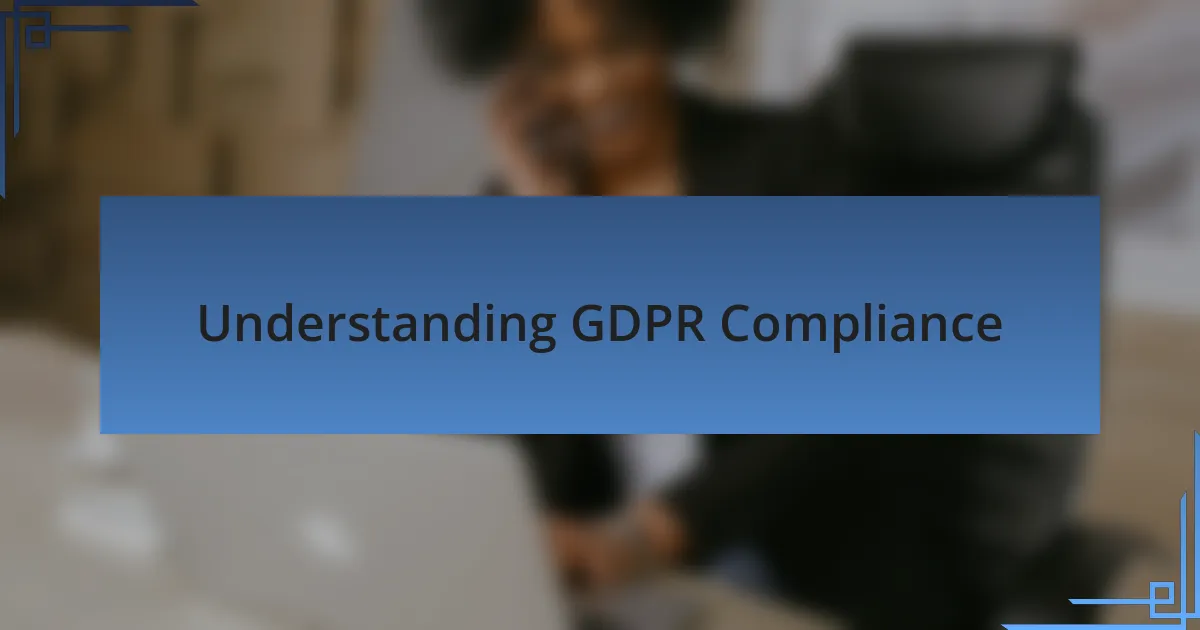
Understanding GDPR Compliance
GDPR, or the General Data Protection Regulation, is a comprehensive framework designed to protect the personal data of individuals within the European Union. When I first delved into GDPR compliance, I found myself overwhelmed by the sheer volume of regulations. But I quickly realized that understanding the core principles—like consent, data minimization, and the rights of individuals—is essential for any business today.
I remember a time when a client of mine was hesitant to implement GDPR-compliant practices, feeling it was unnecessary. This made me reflect on how easy it is to underestimate the importance of data protection. Have you considered how safeguarding customer data can actually enhance trust and credibility in your brand? Compliance isn’t just about avoiding fines; it’s about fostering a culture of respect for privacy.
One crucial aspect of GDPR is the requirement for transparency; businesses must clearly communicate how they collect and use personal data. This requirement often prompts conversations about ethical data practices. Personally, I’ve found that being upfront about data usage not only aligns with GDPR but also strengthens client relationships. Trust often influences customer loyalty—how can your commitment to compliant data handling set you apart in a competitive market?
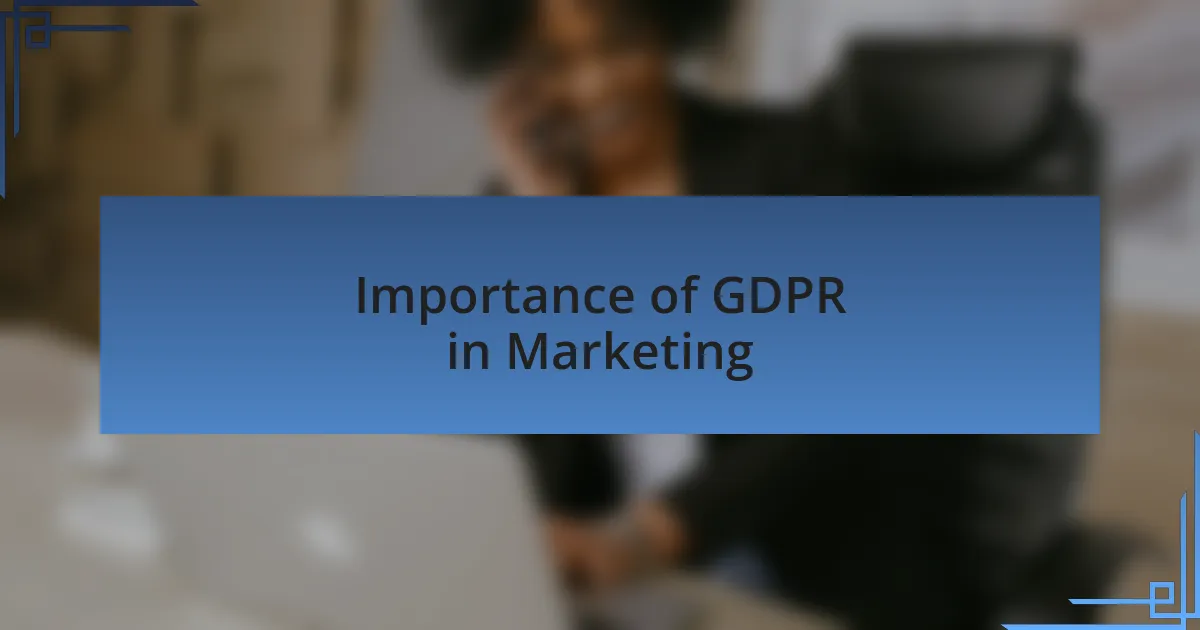
Importance of GDPR in Marketing
The significance of GDPR in marketing cannot be overstated. From my own experience, I’ve seen how compliance creates a solid foundation for building trusting relationships with customers. When consumers know their data is handled securely, they are more likely to engage with your brand, fostering loyalty that can lead to repeat business.
I’ve often asked clients how they view data privacy, and their responses have been enlightening. Many initially see GDPR as a hurdle, yet I’ve convinced them that it’s an opportunity to showcase commitment to consumer rights. This shift in perspective helps brands not only meet legal standards but also resonate with consumers who increasingly value their privacy.
Moreover, the irony is that while some view GDPR as restrictive, it actually encourages marketers to be more strategic and thoughtful in their campaigns. I recall collaborating with a team on a targeted marketing strategy post-GDPR; we prioritized consent-driven approaches and found our engagement rates significantly improved. Isn’t it interesting how respecting user data can transform the way we connect with our audience?
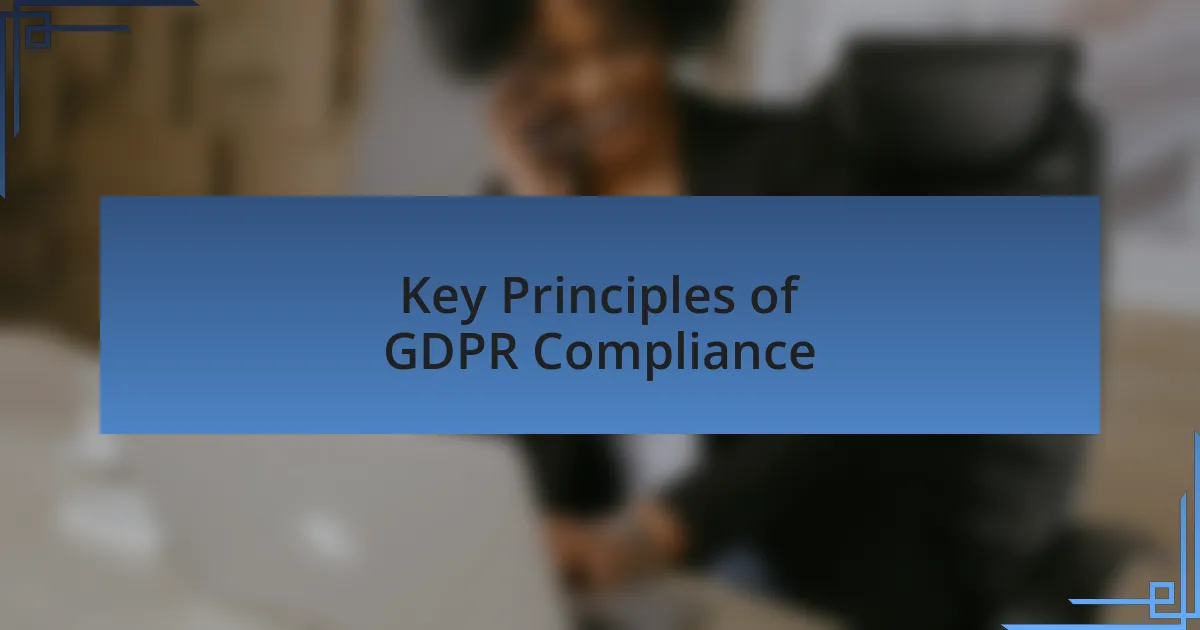
Key Principles of GDPR Compliance
The General Data Protection Regulation (GDPR) revolves around several foundational principles that guide how organizations should handle personal data. One principle that stands out to me is data minimization. This concept emphasizes collecting only the data that is necessary for a specific purpose. I remember when I advised a client to streamline their data collection process, focusing solely on what was essential. The reduction not only eased their compliance worries but also sharpened their marketing efforts, making their outreach more effective.
Accountability is another key principle that resonates with my experience. Organizations must demonstrate compliance, and this means keeping detailed records of data processing activities. I once worked with a brand that implemented comprehensive documentation practices, which not only reassured them during audits but also empowered their team to understand the importance of data protection. Have you ever considered how transparency can build confidence in your brand? It’s a game-changer.
Lastly, the principle of consent cannot be overlooked. For me, obtaining explicit consent from users feels like laying the groundwork for a respectful relationship. From my work, I’ve learned that when customers willingly opt in to receive communications, their engagement levels rise dramatically. It’s fascinating how a simple “yes” can foster a sense of belonging and appreciation among your audience.
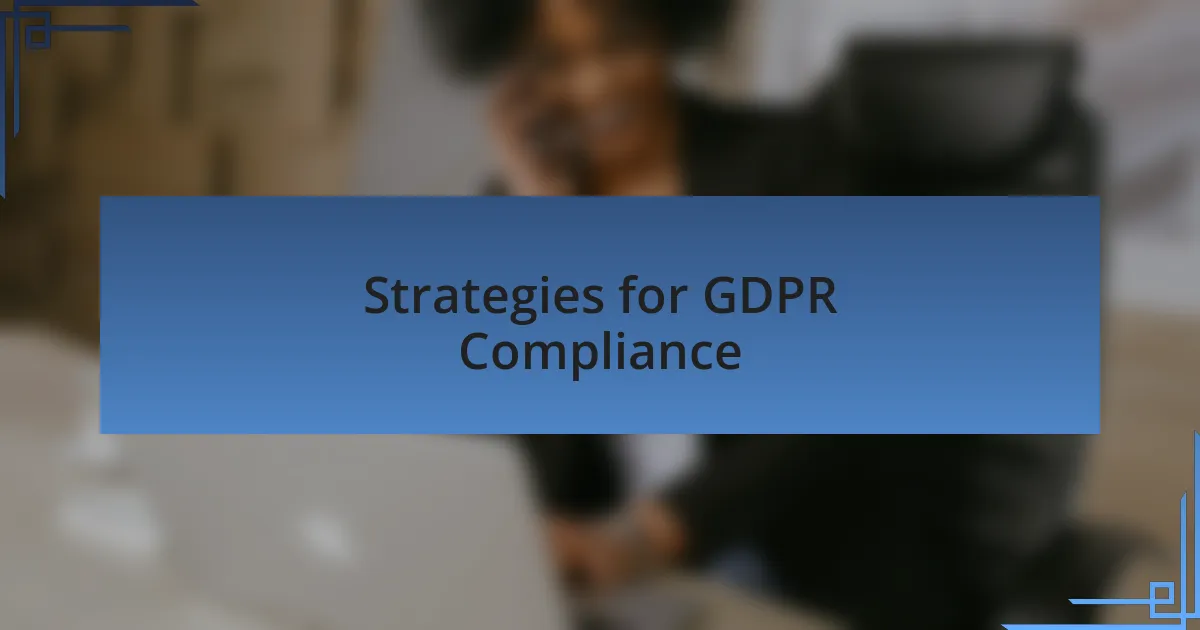
Strategies for GDPR Compliance
When thinking about strategies for GDPR compliance, I often find that conducting regular data audits is essential. In one project, I helped a client analyze their database. We discovered that some old data was not just outdated but unnecessary. By removing this excess, we not only complied with GDPR but also freed up resources to focus on more valuable customer interactions. Have you considered how much you could gain by simply trimming the fat from your data collection?
Another effective strategy involves implementing clear privacy policies. I remember crafting a privacy notice for a startup, focusing on clarity and simplicity. We aimed to communicate what data was collected and how it would be used. The result was remarkable; users appreciated the transparency and felt more inclined to share their information. This experience reinforced my belief that transparency isn’t just a compliance requirement—it’s a trust-building endeavor. Isn’t it rewarding when your audience feels secure in their data-sharing choices?
Training your team on GDPR compliance is another fundamental strategy. I once led a workshop for a marketing team, emphasizing the importance of understanding consent and data rights. Engaging them in real scenarios made the concepts come alive, and it was gratifying to see their enthusiasm. When everyone is on the same page, the organization not only protects itself but also cultivates a culture of respect towards customers’ data. How could a well-informed team enhance your compliance efforts?

Challenges in Achieving Compliance
Achieving GDPR compliance can feel like navigating a complicated maze. One significant challenge I’ve encountered is understanding the nuances of consent. I once had a client who thought their opt-in process was sufficient, but after a close examination, we realized it didn’t meet the strict criteria set by GDPR. This was a wake-up call for us; consent must be clear, informed, and unambiguous. How can organizations ensure they’re collecting consent appropriately if they don’t fully grasp the regulations?
Another hurdle can be the sheer volume of data companies handle. During a recent project with a medium-sized business, we discovered they were storing vast amounts of personal data that went well beyond their operational needs. This not only posed a compliance risk but also overwhelmed their systems. The stress of identifying what to keep and what to delete was immense. Is your organization stuck in a similar data trap, where you’re unsure about what is truly necessary?
Finally, I’ve seen that technology can both help and hinder compliance efforts. For instance, implementing robust data management systems is critical, but these tools can be expensive and complex. I once partnered with a client who hesitated to invest in new software, fearing it would disrupt their workflow. Ultimately, we learned that the right technology not only streamlines compliance but also enhances operational efficiency. Have you considered whether your existing tools are truly supporting your compliance journey, or are they just delaying it?

My Personal Experience with GDPR
One of my earliest encounters with GDPR was during a seminar where the speaker shared a real-life case study about a company facing heavy fines. As I listened, I couldn’t help but think about how easily a business can slip into non-compliance without even realizing it. I remember feeling a mixture of anxiety and determination; it sparked in me a strong desire to help clients navigate these regulations, ensuring they were aware of the potential pitfalls.
I recall a specific moment when discussing data retention policies with a client. We had a lengthy conversation about the importance of limiting data storage, and I noticed their initial reluctance. They were so attached to historical data, thinking it might be useful one day. It reminded me of how difficult it can be to let go of what seems valuable, but I also emphasized that keeping unnecessary data not only jeopardizes compliance but also complicates operations. Have you ever found yourself clinging to outdated information, thinking it might be useful down the line?
I’ve seen the profound impact of GDPR on company culture, especially when it comes to transparency. One client went through a transformation after we refined their privacy policy, becoming so passionate about data rights that they turned compliance into a core value of their brand. Witnessing this shift made me realize that GDPR compliance isn’t just about avoiding fines; it’s about fostering trust with customers. How much do you think trust impacts your relationship with your clients? For me, it’s everything.
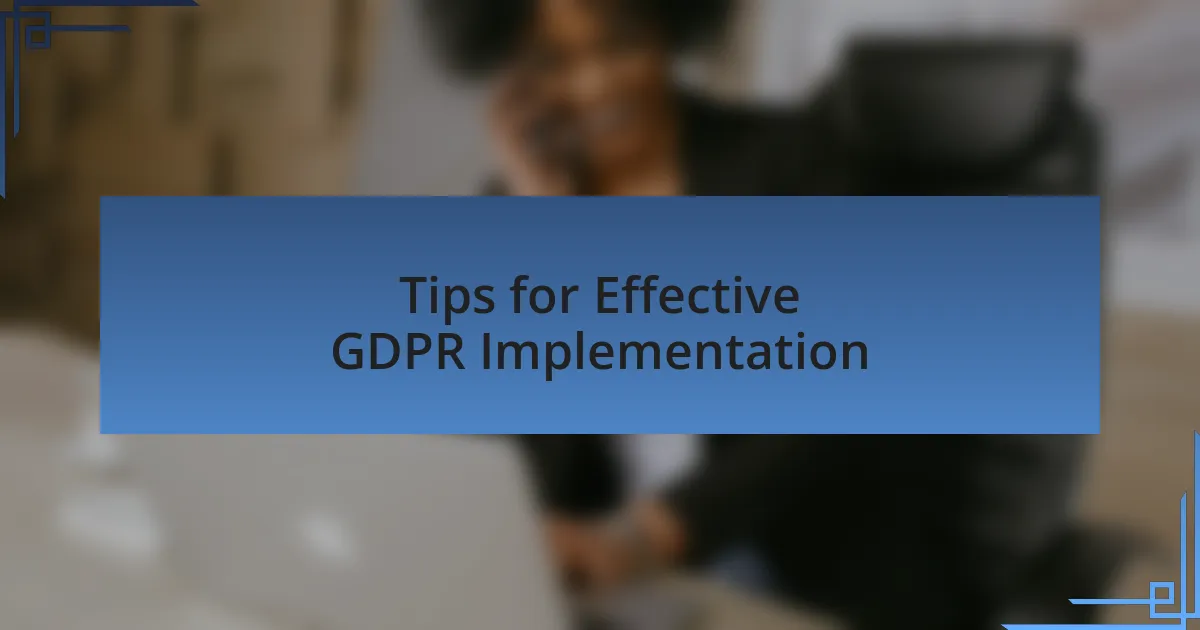
Tips for Effective GDPR Implementation
When implementing GDPR, I always stress the value of conducting a comprehensive data audit first. I remember working with a startup that hadn’t mapped out their data flows. Once we identified where customer data was stored and how it was used, the entire team gained clarity. It felt empowering to see them take ownership of their compliance journey. Have you taken the time to really understand your data?
Another essential tip is to prioritize ongoing training for your team. I once facilitated a workshop where we role-played various scenarios involving customer data handling. The energy in the room shifted as my colleagues began to see the real-world implications of compliance. It was a reminder that understanding regulations isn’t just a checkbox; it’s about creating a culture of mindfulness around data. What strategies do you use to keep your team informed?
Lastly, don’t underestimate the importance of clear communication with your customers. I found that updating privacy policies in straightforward language can transform client relationships. Once, I helped a client craft a more transparent GDPR notice, which led to an increase in customer inquiries and engagement. It felt rewarding to see how open communication fostered trust. How do you express your commitment to data protection to your clients?